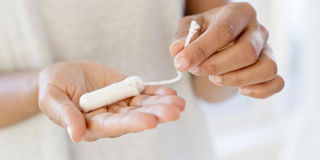Prime
Are tampons safe?

The most important thing to remember is to care about your personal hygiene and to change your tampon every after eight hours. STOCK Photo
What you need to know:
Tampons are popular for the convenience provided during menstruation. However, everything convenient is not necessarily good and healthy. The same goes for tampons.
Just like ordinary pads, tampons are used by women during their period. However, unlike pads which are attached to the woman’s knicker so as to hold the flow, tampons are inserted into the vagina. They are cylindrical in shape and made of cotton, rayon, or a blend of the two.
Resty Komujuni attests to the convenience of using tampons saying: “Not only are they comfortable, but minimise the chances of clothes getting soiled. They also give me freedom to wear shorts and dresses not to mention swim during a menstrual period.”
Dr Paul Kato, an obstetrician and gynecologist at Span Medical Centre, says tampons are designed either to be inserted using a plastic or cardboard applicator or put directly, without an applicator. However, Komujuni says not everything comfortable is necessarily healthy.
“After years of using tampons, I saw their downside when I used them for longer than I usually did,” she says adding, “One Monday morning, I forgot to change the tampon I had slept with because I was late and every second mattered. I started feeling an irritation around my vaginal skin that later broke into rashes and a burning sensation. Before long, I started experiencing excessive itching in my private parts coupled with lower abdominal pain and backache. At around 3pm, I remembered to change the tampon.
Effects
While Komujuni later got better upon taking prescribed medication, not all are lucky. Wendy Nabirye suffered more than backache and lower abdominal pain as the infection earlier seen in the urinary test would later evolve into a toxic shock syndrome (TSS).
“While I had started taking medication, one day, I woke up feeling extremely ill with a fever, vomiting and feeling extremely tired coupled with a rash in my private parts,” she says.
Calling the gynecologist regarding her condition, Nabirye was advised to head to the hospital immediately. “I was admitted as soon as my vitals had been taken and a drip given. Later, the doctor told me that if I had come later than I had, I would have had to undergo surgery to clean out any infected wounds,” she recalls.
Toxic shock syndrome
Dr Franklin Wasswa of Entebbe General Hospital says: “The biggest danger about leaving tampons in the vagina for more than eight hours is TSS. It is brought about by a bacteria called Staphylococcus aureus or Streptococcus pyogenes which lives on our skin as normal flora.”
However, when normal flora increases beyond a certain population, Dr Kato says they can cause life-threatening infections, in this case, TSS.
He further explains that TSS was classically associated with high absorbency tampons used in menstruating women until eventually, these were taken off the market.
Toxic shock syndrome (TSS) is an acute-onset illness characterised by fever, hypotension, sunburn-like rash, and end-organ damage. Younger women are more likely to get TSS, possibly because of more exposure through tampons or barrier contraceptive use.
TSS cause
Dr Wasswa explains that it produces a poison or simply put ‘sweat’ (exotoxin), which enters the woman’s bloodstream in the body, and signals the body’s defensive mechanism to destroy cells and tissues.
This is why TSS results in multi-organ failure because of the huge destruction of cells and tissues in the whole body.
He thus advises that a tampon should be used for a maximum of eight hours as the dangers of TSS are fatal and, therefore, a medical emergency.
In recent years, he explains, menstrual cups—flexible cups that are inserted into the vagina during a period to collect menstrual blood—have been touted as a safer alternative to tampons.
However, these have also been met with conflicting safety reports. Therefore, while tampons are generally safe, it is imperative that they are used properly.
Safety concerns
Dr Kato shares what every woman ought to do when using tampons:
Hand washing: This will help prevent the transfer of bacteria from your hands to the tampon.
Change every four to eight hours: It is recommended that a tampon should not be left in the vagina for more than eight hours at a time. Bacteria can grow on a tampon that is left in for too long, increasing the risk of vaginal or bladder infections, as well as toxic shock syndrome (TSS).
Use low absorbent tampon: If some days of your period are light, an excessively absorbent tampon can increase your risk of vaginal dryness because it can absorb the normal protective lubrication of the vagina. This is because while these excessive absorbing tampons are no longer being produced, there are chances that they could still be on the market.
Change your tampons after a bowel movement: Faeces contain a lot of bacteria which can contaminate the string that hangs out of the tampon, exposing you to potential vaginal or urinary tract infections.
Use tampons only with a period: Leaving a tampon in when you do not have your period causes vaginal dryness and increases the risk of TSS. One is better-off using a pad or a panty liner.




